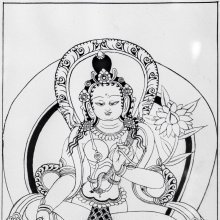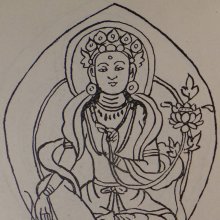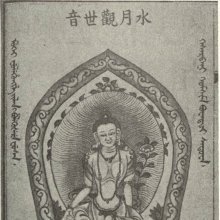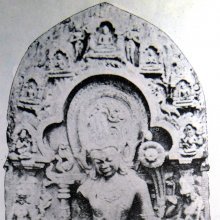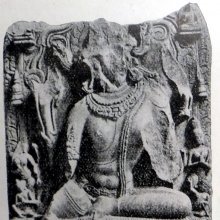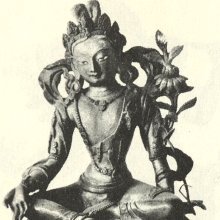Khasarpana, Khasarpaṇa: 8 definitions
Introduction:
Khasarpana means something in Buddhism, Pali, Hinduism, Sanskrit. If you want to know the exact meaning, history, etymology or English translation of this term then check out the descriptions on this page. Add your comment or reference to a book if you want to contribute to this summary article.
Images (photo gallery)
(+5 more images available)
In Buddhism
Tibetan Buddhism (Vajrayana or tantric Buddhism)
Source: archive.org: The Indian Buddhist Iconography1) Khasarpaṇa (खसर्पण) or Khasarpaṇalokeśvara refers to one of the various forms of Avalokiteśvara having their Sādhana described in the 5th-century Sādhanamālā (a collection of sādhana texts that contain detailed instructions for rituals).—His Colour is white; his Symbol is the lotus; his Mudrā is the varada; his Āsana is the lalita or the ardhaparyaṅka.—The peculiar feature of this god [Khasarpaṇa] is that he is invariably accompanied by the four divinities Tārā, Sudhanakumāra, Bhṛkuṭī and Hayagrīva.
The Dhyāna (meditation instructions) of Khasarpaṇa is described in the Sādhanamālā as follows:
“The worshipper should think himself as the god (Khasarpaṇa) from whose body radiate rays of a crore of moons. He wears the Jaṭāmukuṭa (crown of matted hair), holds the image of Amitābha on his head, and sits on the moon over a double lotus in the ardhaparyaṅka attitude. He is decked in all sorts of ornaments, has a smiling face, is aged about twice eight years, exhibits the Varada pose in the right hand, and holds the lotus with a stem in the left. He is an expert in distributing the stream of nectar that flows from his hand, and Sūcīmukha who stands below with an uplifted face, aprotruding belly and very pale appearance receives the same. He resides in the womb of the mount Poṭalaka, looks beautiful with compassion, is full of the sentiment of Śṛṅgāra (amour), is extremely peaceful and is endowed with various auspicious marks”
“Before him is Tārā and to the right is Sudhanakumāra”
“Here Tārā is green. She causes to blossom with her right hand the lotus flower with a stem held in her left. She has many ornaments and her breasts are oppressively heavy due to adolescence”.
“Sudhanakumāra, again, has his two hands joined (añjali), is resplendent like gold, and has the appearance of a prince. He carries the book under his left arm-pit and is decked in all ornaments.”
“To the West of the god is Bhṛkuṭī and to the North Hayagrīva”
“Here Bhṛkuṭī has four arms, is resplendent like gold has mattedhair, carries the staff with three horns and the Kamaṇḍalu in the two left hands. The two right show the mudrā of bowing in one and the rosary in the second. She has three eyes.
“Hayagrīva is red in colour and is short, with a protruding belly. His hair rises upwards in the shape of a flame, and he has a snake as his sacred thread. His face is recognised by a deep brown pair of moustaches; his eyes are red and round; his eye-brows are distorted in a frown. He is clad in tiger-skin, has the staff as a weapon, and his right hand exhibits the act of bowing.”
“All these deities should be meditated on as disposed in a befitting and artistic manner, with their eyes directed towards the face of the principal deity. Here ends the Sādhana for Khasarpaṇa”
2) Khasarpaṇa (खसर्पण) or Khasarpaṇalokeśvara refers to number 21 of the 108 forms of Avalokiteśvara found in the Machhandar Vahal (Kathmanu, Nepal). [Machhandar or Machandar is another name for for Matsyendra.].
Accordingly,—
“Khasarpaṇa is one-faced and two armed and sits in the Lalita attitude on a lotus. His right hand exhibits the Varada pose and the left is raised against the chest, holding the stem of a lotus”.
The names of the 108 deities [viz., Khasarpaṇa] possbily originate from a Tantra included in the Kagyur which is named “the 108 names of Avalokiteshvara”, however it is not yet certain that this is the source for the Nepali descriptions. Tibetan Buddhism includes schools such as Nyingma, Kadampa, Kagyu and Gelug. Their primary canon of literature is divided in two broad categories: The Kangyur, which consists of Buddha’s words, and the Tengyur, which includes commentaries from various sources. Esotericism and tantra techniques (vajrayāna) are collected indepently.
Languages of India and abroad
Sanskrit dictionary
Source: DDSA: The practical Sanskrit-English dictionaryKhasarpaṇa (खसर्पण).—Name of a Buddha.
Derivable forms: khasarpaṇaḥ (खसर्पणः).
See also (synonyms): khasama.
Source: Cologne Digital Sanskrit Dictionaries: Edgerton Buddhist Hybrid Sanskrit DictionaryKhasarpaṇa (खसर्पण).—(1) name of a Buddha: namaḥ Khasarpa-ṇāya (or śrī-Kha°) Sādhanamālā 36.9; 38.1; 42.8; (2) name of a village: Sādhanamālā 42.11.
Source: Cologne Digital Sanskrit Dictionaries: Shabda-Sagara Sanskrit-English DictionaryKhasarpaṇa (खसर्पण).—m.
(-ṇaḥ) One of the Bud'dha or Boud'dha saints. n.
(-ṇaṃ) Gliding through the air. E. kha heaven, and sarpaṇa who goes to or in.
Source: Cologne Digital Sanskrit Dictionaries: Monier-Williams Sanskrit-English Dictionary1) Khasarpaṇa (खसर्पण):—[=kha-sarpaṇa] [from kha] m. Name of a Buddha, [cf. Lexicographers, esp. such as amarasiṃha, halāyudha, hemacandra, etc.]
2) [v.s. ...] n. gliding through the air, [Horace H. Wilson]
Source: Cologne Digital Sanskrit Dictionaries: Yates Sanskrit-English DictionaryKhasarpaṇa (खसर्पण):—[kha-sarpaṇa] (ṇaḥ) 1. m. One of the Buddhas. n. Gliding through the air.
[Sanskrit to German]
Sanskrit, also spelled संस्कृतम् (saṃskṛtam), is an ancient language of India commonly seen as the grandmother of the Indo-European language family (even English!). Closely allied with Prakrit and Pali, Sanskrit is more exhaustive in both grammar and terms and has the most extensive collection of literature in the world, greatly surpassing its sister-languages Greek and Latin.
See also (Relevant definitions)
Partial matches: Kha, Sarpana.
Starts with: Khasarpanalokeshvara.
Full-text: Khasama, Khasarpanalokeshvara.
Relevant text
Search found 4 books and stories containing Khasarpana, Khasarpaṇa, Kha-sarpana, Kha-sarpaṇa; (plurals include: Khasarpanas, Khasarpaṇas, sarpanas, sarpaṇas). You can also click to the full overview containing English textual excerpts. Below are direct links for the most relevant articles:
The Indian Buddhist Iconography (by Benoytosh Bhattachacharyya)
108 forms of Avalokiteśvara (21): Khasarpaṇa Lokeśvara
Figure 103-104 - (Avalokiteśvara): Khasarpaṇa
Blue Annals (deb-ther sngon-po) (by George N. Roerich)
Chapter 4 - Lineage of Tropuwa < [Book 14 - Great Compassion Cycle]
Chapter 2 - Introduction: The Lineage of the Sādhana < [Book 14 - Great Compassion Cycle]
Chapter 12 - Teurapa (rte'u ra pa'i skabs) < [Book 14 - Great Compassion Cycle]
Lord Hayagriva in Sanskrit Literature (by Anindita Adhikari)
Hayagrīva in Buddhism < [Chapter 6]
Settlement in Early Historic Ganga Plain (by Chirantani Das)
Part 7 - Nalanda’s Rise of a Multi-functional Nodal Centre < [Chapter III - Nālandā: Evidence for rise and progress of the settlement]
Related products
